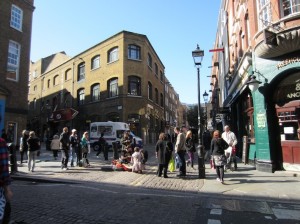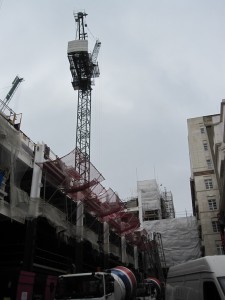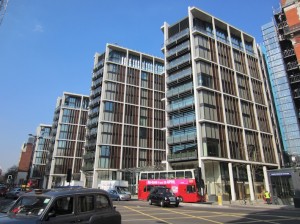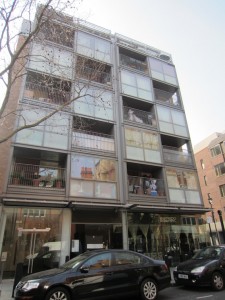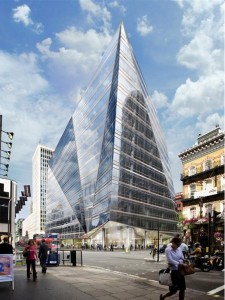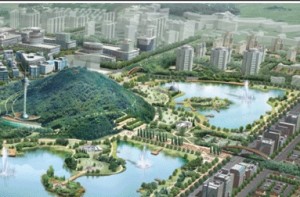OC 53: Stag Place Revisited
Urban transformation: for better or for worse: – then?
In the early nineteen seventies, I asked my post graduate students to explore two areas of central London of equal size, and observe their fabrics and how they were used to identify what interventions they could propose as aspiring urbanists to improve them. One area was near Victoria station, one of the head stations on the inner ring of London, where the site of a decommissioned brewery had been redeveloped according to modernist principles.

1_dia Victoria Street during the war source: http://www.westendatwar.org.uk/page_id__169_path__0p28p.aspx
It was turned into ‘Stag Place’, surrounded by high office blocks accommodating head quarters of international oil companies.
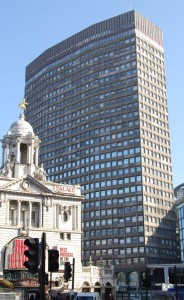
2_dia 1960s Stag Place redevelopment: 99m high Portland House (Oil and Gas UK)
source: http://postwarbuildings.com/buildings/portland-house
The other area was on the doorstep of their school in central London, in the midst of a complex weave of Fitzrovia a mixed ethnic area, Bloomsbury a Great Estate, Covent Garden recently abandoned as whole sale market, and Soho notorious for its night life.
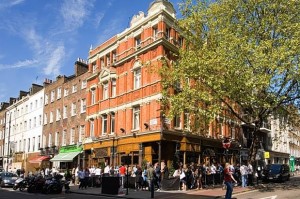
3_dia Street life in Fitzrovia central London source: http://www.standard.co.uk/comment/comment/dont-let-business-in-to-destroy-unique-fitzrovia-8069360.html
It was a real challenge to get the students interested in a new modernist development, something that should have been closest to their design experience. They all wanted to work in the complex historic urban environment surrounding them. For them Stag Place was deadly, boring, unattractive. Nobody wanted to be there, although it was near a busy station from where large numbers of commuters reached their offices and international travellers arrived at the time. The office blocks created wind turbulence, making the overshadowed open square inhospitable. The regeneration with new glass and steel buildings inaugurated in 2004 has not improved the micro-climate and few people sit in the draught under the glass canopy. In short, Stag Place remains a design problem that no amount of urban change was able to improve. Could I blame my students for choosing the ‘easy option’, an already diverse mixed fabric, with only a few scars driven through it by transportation engineers and the threat to flatten Covent Garden for more urban motorways, convention centres and multi-story car parks?
Urban transformation: for better or worse: – now?
Stag Place, now renamed Cardinal Place, is in the limelight again. Recently, developers have set up a BID (Business Improvement District) to reshape the open areas in front of Victoria station which includes an awkward bus station.
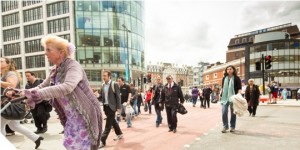
5_dia Victoria Station BID with Works and Pensions grant source: http://www.victoriabid.co.uk/news-and-press/funding-from-the-department-of-work-and-pensions/
Now a developer wants to change one of the nineteen-sixties office blocks into housing, after having been prevented by the planners to replace it with higher density buildings reaping higher yields. This has released a heated debate among urbanists and urban activists about changing offices into housing, for the simple reason that the yield of housing in inner London is higher than that of offices at present, in other words for purely financial reasons. As the planning system has steadily shifted towards development-led principles, what justifications could retain work places in this inner London area?
Housing vs offices
With its rapid demographic growth, London is in need of housing. The question is what housing though. Densification pushed by the last labour government has spawned a great increase of interventions in city centres, adding stories to existing buildings, filling gaps between buildings with gated car parks on the ground floors, building over open spaces, often with small units without day- or sunlight, proper kitchen or storage space, all initiatives which may possibly become the slums of tomorrow.
Alongside, ‘luxury’ blocks of flats replaced historic buildings on prestigious sites, purchased for investment, rarely inhabited, thus not contributing to urban life.
Affordable housing was rarely among these development-led schemes. The proposed flats in the office block will not form part of affordable housing either which is getting rare in inner London, thus pushing low income people out of the area.
What housing, what workplaces, what alternatives?
Should the argument be between housing to replace workplaces in an area which is not really dominated by offices, or should it be about providing more affordable housing to maintain some mix between high and low income people in the centre of the city? The discussion within the Planning and Development Forum (see Planning in London Issue 82, 2012) was certainly polarised and nobody proposed a ‘third way’, something that seems to have gone into disrepute, together with common sense.
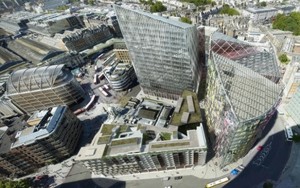
9_Proposed redevelopment of Cardinal Place with luxury flats and offices. Source: http://www.telegraph.co.uk/finance/newsbysector/constructionandproperty/9084608/Land-Securities-finds-partner-for-Victoria.html
Despite the on-going promotion of mixed development, it will not happen without change in the property market. Ground floors remain blind and are getting more so when buildings are sold in syndicated form, as abstract parcels akin to shares and stocks. A single tenant, a corporation on a long lease is preferable and much cheaper to manage than a messy mix of ground floor tenants who use their premises for retail or small offices, let alone a whole building occupied by all sorts of users, ranging from weekday residencies to artisanal activities, spaces for child care to artist studios. Compatibility of use may remain an issue, but little opportunity exists for work-life accommodation or any other activity which would deviate from pure residing or pure office work.
Other forces are at work as well, such as availability of mortgage borrowing and increased risk of falling house prices. The argument of land scarcity is disputed as well, as scarcity applies to what type of land is desired, not whether there is land available in areas of opportunity for example. The ultimate argument is about value-added generated by development and how it should be (re-) distributed fairly. Neither the present planning system nor political objectives aim at an equitable balance between private gain and public interest.

